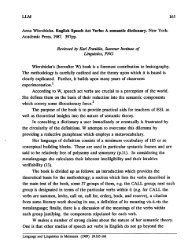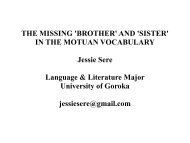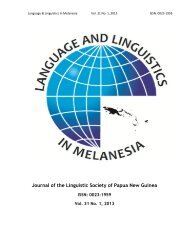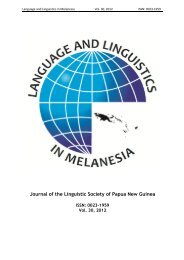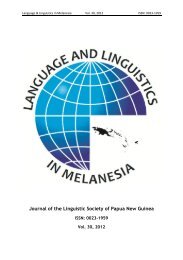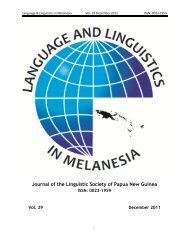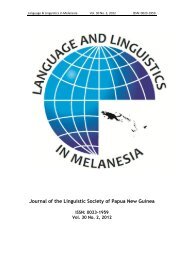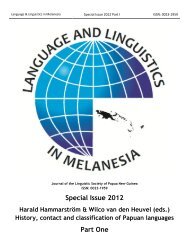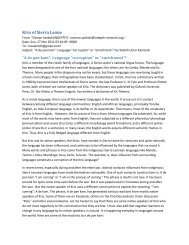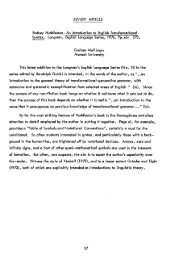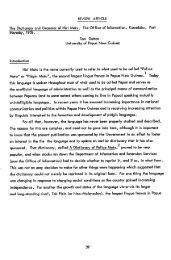Journal of the Linguistic Society of Papua New Guinea
Journal of the Linguistic Society of Papua New Guinea
Journal of the Linguistic Society of Papua New Guinea
Create successful ePaper yourself
Turn your PDF publications into a flip-book with our unique Google optimized e-Paper software.
Language & <strong>Linguistic</strong>s in Melanesia Vol. 30 No. 2, 2012 ISSN: 0023-1959<br />
function (Noun, Adjective or<br />
Adverb). In this floor mosaic<br />
in Dallas International<br />
Airport (photo taken in<br />
02/2012), it is groups <strong>of</strong> tiles<br />
that toge<strong>the</strong>r form <strong>the</strong> bird’s<br />
wings, tail, eye, beak, etc.:<br />
Generalizing syntactic<br />
analysis (G-nalysis) focuses<br />
on how words and groups <strong>of</strong><br />
words function in <strong>the</strong><br />
sentence, forming chunks <strong>of</strong><br />
meaning in <strong>the</strong> overall<br />
sentence mosaic. Associating ideas by resemblance, contiguity, and cause/effect comes to us naturally,<br />
because our thoughts reflect our experiences in <strong>the</strong> 4-D physical world – we perceive resemblance<br />
between things, and <strong>the</strong> various spatial, temporal and causal relationships between <strong>the</strong>m. The so-called<br />
‘journalistic’ questions ‘Who, Does What, to Whom, How, When, Where, and Why’ reflect <strong>the</strong><br />
relationships between <strong>the</strong> things we observe; word-meanings that answer <strong>the</strong>se questions (singly or<br />
‘working toge<strong>the</strong>r’ in groups) are classed as different ‘Parts <strong>of</strong> Speech,’ depending on what <strong>the</strong>y do in<br />
<strong>the</strong> sentence/ which question <strong>the</strong>y answer:<br />
Word Function Answer Questions:<br />
Nouns Words/phrases/clause that name things What Who<br />
Pronouns stand instead <strong>of</strong> nouns What Who<br />
Adjectives<br />
Verbs<br />
Words/ phrases/ clauses that describe nouns by<br />
RESEMBLANCE<br />
Which What kind<br />
name actions or states <strong>of</strong> being, while carrying also <strong>the</strong> meaning <strong>of</strong> time [SYNTHESIS/<br />
CONJUGATION with SUBJECT]:<br />
A verb is that which, in addition to its proper meaning, carries with it <strong>the</strong> notion <strong>of</strong> time … It is a<br />
sign <strong>of</strong> something said <strong>of</strong> something else. (Aristotle)<br />
Adverbs<br />
Conjunctions<br />
describe verbs by<br />
RESEMBLANCE:<br />
CONTIGUITY I in space/time:<br />
CAUSE/EFFECT:<br />
*Adverbs also describe adjectives (qualities)<br />
join words, phrases & clauses [CONTIGUITY]<br />
How<br />
Where When<br />
Why With what<br />
consequence On what<br />
condition et cetera<br />
Prepositions<br />
Interjections<br />
Are <strong>the</strong> ‘connective tissue’; <strong>the</strong>y show relative ‘positions’ <strong>of</strong> things in space and time<br />
[CONTIGUITY]<br />
expressions <strong>of</strong> speakers’ feelings & attitudes interjected, or ‘thrown into’ <strong>the</strong> midst <strong>of</strong> a<br />
clause: <strong>the</strong> ‘SPICES’<br />
36



